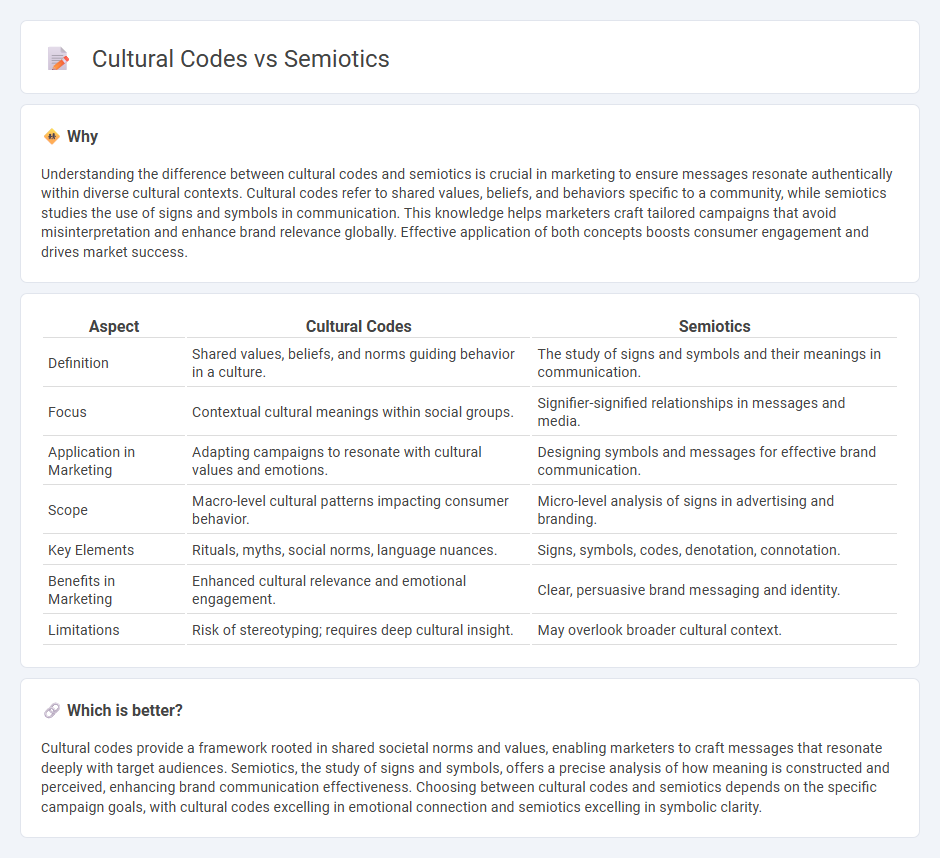
Cultural codes shape consumer behavior by embedding shared values and symbols within marketing messages, enhancing brand resonance across diverse audiences. Semiotics decodes these symbols to interpret underlying meanings, enabling marketers to craft more effective communication strategies. Explore how understanding cultural codes and semiotics can elevate your marketing impact.
Why it is important
Understanding the difference between cultural codes and semiotics is crucial in marketing to ensure messages resonate authentically within diverse cultural contexts. Cultural codes refer to shared values, beliefs, and behaviors specific to a community, while semiotics studies the use of signs and symbols in communication. This knowledge helps marketers craft tailored campaigns that avoid misinterpretation and enhance brand relevance globally. Effective application of both concepts boosts consumer engagement and drives market success.
Comparison Table
| Aspect | Cultural Codes | Semiotics |
|---|---|---|
| Definition | Shared values, beliefs, and norms guiding behavior in a culture. | The study of signs and symbols and their meanings in communication. |
| Focus | Contextual cultural meanings within social groups. | Signifier-signified relationships in messages and media. |
| Application in Marketing | Adapting campaigns to resonate with cultural values and emotions. | Designing symbols and messages for effective brand communication. |
| Scope | Macro-level cultural patterns impacting consumer behavior. | Micro-level analysis of signs in advertising and branding. |
| Key Elements | Rituals, myths, social norms, language nuances. | Signs, symbols, codes, denotation, connotation. |
| Benefits in Marketing | Enhanced cultural relevance and emotional engagement. | Clear, persuasive brand messaging and identity. |
| Limitations | Risk of stereotyping; requires deep cultural insight. | May overlook broader cultural context. |
Which is better?
Cultural codes provide a framework rooted in shared societal norms and values, enabling marketers to craft messages that resonate deeply with target audiences. Semiotics, the study of signs and symbols, offers a precise analysis of how meaning is constructed and perceived, enhancing brand communication effectiveness. Choosing between cultural codes and semiotics depends on the specific campaign goals, with cultural codes excelling in emotional connection and semiotics excelling in symbolic clarity.
Connection
Cultural codes shape the underlying meanings and values embedded in marketing messages, while semiotics analyzes these signs and symbols to decode consumer interpretations. Understanding the relationship between cultural codes and semiotics enables marketers to craft campaigns that resonate deeply with target audiences by leveraging culturally relevant symbols. Effective application of semiotic principles helps brands communicate more authentically and enhances emotional engagement across diverse markets.
Key Terms
Signifiers
Semiotics explores signifiers as fundamental units of meaning, focusing on how signs represent concepts or objects within communication systems. Cultural codes shape these signifiers by embedding them with specific social or cultural meanings that influence interpretation and understanding. Discover how the interplay between semiotic signifiers and cultural codes affects communication and perception in diverse contexts.
Meaning-making
Semiotics studies signs and symbols as fundamental units of meaning-making, analyzing how meaning is constructed and interpreted through linguistic, visual, and auditory systems. Cultural codes represent shared values, norms, and conventions within a society that influence these signs' interpretation, embedding collective meanings in communication. Explore how integrating semiotics with cultural codes enhances understanding of meaning-making processes across diverse contexts.
Symbolic systems
Semiotics studies signs and symbols as elements of communicative behavior, analyzing how meaning is constructed and interpreted within symbolic systems. Cultural codes refer to the shared values, norms, and conventions embedded in a society that influence how symbols are understood and used in communication. Explore deeper insights into how symbolic systems shape cultural meaning and interaction.
Source and External Links
Semiotics - Semiotics is the systematic study of interpretation, meaning-making, and the communication of meaning through signs and symbols.
Semiotics Definition & Examples - This resource defines semiotics as the study of how words and other symbolic systems of communication create meaning, with examples and applications in various fields.
What is Semiotics: Definitions, Origins and Applications - It explores the study of signs and symbols and how they are used to create meaning, facilitating communication and understanding in different contexts.
 dowidth.com
dowidth.com